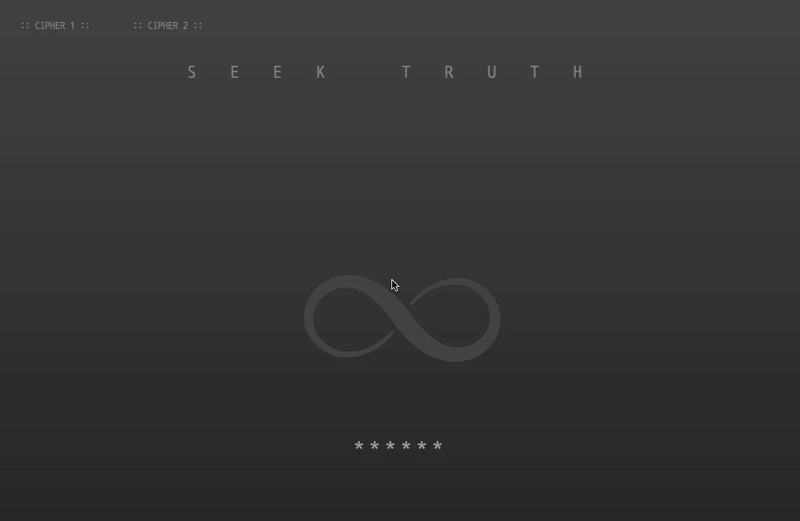This app is the result of my week 9 group project, for CodeClan's professional software development course. The MEVN stack was used to create a puzzle based web app to be used as a marketing tool for local events.
Built in the vein of Cicada 3301, GCHQ's "Can you find it?", and events like Puzzled Pint; the project would rely on word of mouth and problem solving discussions on social media to drive traffic towards local events.
The landing page of the web app is built deliberately against UX principles to pose a challenge to the user. After solving the riddle and entering the password, the user is directed to an event details page. You can also access the admin page by entering the admin password.
- Mongo
- Express
- Vue
- Node
The back-end of the project is a CRUD RESTful app using mongo, express, and node. It's also responsible for checking the riddle solutions/admin password before supplying the event data.
The front-end of the project consists of three views: landing page, user page, and admin page. Routing to these pages is password dependent from the landing page.
The project runs in two docker containers, with a third used to seed the database. You'll need Docker and docker-compose installed to create and start the Docker images:
docker-compose up
You can also use the -d tag to run the containers in detached mode. Once you are finished, stop the server using:
docker-compose down
Or ctrl-c to cancel within the non-detached mode terminal window.
The mongo database has two collections shindigs (events) and users. The shindigs collection is not directly accessible from the landing page to prevent users from bypassing the riddle. A separate router was created to provide access to only the shindig's id and riddle question.
const riddlesRouter = express.Router(); riddlesRouter.get('/', (req, res) =>{
shindigsCollection.find().toArray()
.then(docs => docs.map(doc => {
return {
shindigId: doc._id,
riddleQuestion: doc.riddleQuestion
}
}))
.then(riddles => res.json(riddles))
.catch(errorLog)
})The riddle answers are also checked via the riddles router to prevent direct access. The provided answer is first checked against the hardcoded admin password, followed by the riddle answer. This will return either the code admin or a full shindig object as the response. If neither is matched, an error message is passed to the front end.
riddlesRouter.post('/submit-answer', (req, res) => {
const body = req.body;
const userAnswer = body.userAnswer.toLowerCase();
const shindigId = body.shindigId;
shindigsCollection.findOne({
_id: ObjectId(shindigId)
})
.then(shindig => {
if (userAnswer === 'hunter2') {
res.json('admin')
}
else if (userAnswer === shindig.riddleAnswer) {
res.json(shindig)
}
else {
res.json({ error: 'ERROR' })
}
})
.catch(errorLog)
})The front-end then uses this response to determine which page to show: admin, error, or user. The routing is achieved by switching boolean values used in v-if directives for the page views. Alternatively, if the user provides an incorrect answer the page is wiped, and a fake error page is shown.
if (data === 'admin') {
this.showUserPage = false
this.showRiddlePage = false
this.showAdminPage = true
}
else if (data.error) {
const clearPage = document.getElementById('app');
clearPage.innerHTML = "";
const image = document.createElement('IMG')
image.src = 'http://getwallpapers.com/wallpaper/full/0/3/5/40874.jpg';
clearPage.appendChild(image);
}
else {
this.selectedShindig = data
this.showUserPage = true
this.showRiddlePage = false
this.showAdminPage = false
}The 'seek truth' text and the sliding document are animated using css transitions. The animations are stored in css classes which are added and removed to the relevant objects in the DOM.
slideIn(){
this.reduceLetterSpacing();
const topSecretDocument = document.getElementById('secret-document');
topSecretDocument.classList.add('slideIn');
}The slide out effect is achieved by removing the slideIn class.
.slideIn {
transform: translateY(-55vh);
transition: transform 2s;
opacity: 1;
}- Add more puzzles with different formats, to keep the app interesting.
- Improve the aesthetic of the admin/user pages.
- Refactor the routing to use vue router to improve the behaviour of the website and tidy up the logic.
- Improve security: refactor the admin page into a separate app. This would further limit user access to the event data by allowing the removal of the api/shindigs route.
